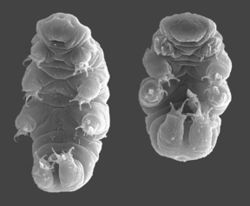I am walking through thick dark-green vegetation; everything is soaked and I am knee deep in water – the rains came last night after the summer drought, and the plants are making the most of it. The plant stems are thick and swollen with water, they are so close together that I feel like I am walking through a carpet. As I push through some dense dead material I walk out into a sun-filled glade, a pool that has been filled by the rain lies in the middle. I then notice that there is a large spherical, crinkled object floating on the surface which begins to make cracking noises as I watch. I am suddenly aware of danger, the object is twitching and I feel uneasy so I run to the other side of the glade and am about to disappear into the foliage when I stop; my curiosity is too strong. I look back at the object and I am shocked to see that it has unfurled like a fern and is now standing on the edge of the pool. The creature has eight thick legs each ending in four sharp claws, its body is nut-brown and barrel shaped, its head is small but has a circular mouth with dagger-like teeth set around the edge. It is enormous but it moves slowly and clumsily as it clutches at the plant stems around it and hauls its bear-like body out of the water, without warning it turns its head straight at me and lets out a bellow which any animal on Earth would recognise as hunger.
That fictional encounter is what it might be like to be shrunk down to about 0.25mm in height and placed in a clump of moss that is crawling with Water-bears – a bit scary perhaps? Well fortunately for us, Tardigrades (also known as water-bears or moss-piglets) are only around 0.5mm long and eat plant matter and microbes. These are fascinating creatures that live all around us in vast numbers, they are segmented micro-animals which live in almost every habitat imaginable but can most often be found in moss, lichen, soil and beaches. To see one requires a microscope, but it needn’t be high magnification – once located a water bear can be seen with the naked eye, this makes them very accessible for people like you or me and gives a very interesting insight into the microscopic world around us.
There are more than 1,150 species of Tardigrade so far identified, including fossilized specimens (can you imagine searching rocks for these tiny things!) and despite their cute appearance they are probably the toughest organism on Earth. They are well known for their ability to survive extremes; water bears can survive temperatures as high as 151 degrees Celsius or as low as -200 degrees, they can survive 1000 times more radiation than other animals, they can withstand immense pressures and even the vacuum of space! They are best known though for their ability to undergo cryptobiosis; whereby their metabolism is reduced to 0.01% of normal and they lose all but 3% of water in their body, this state is known as a ‘Tun’ and enables the Tardigrade to survive in a dehydrated state for up to a decade.
Now that is impressive! These are the sort of creatures you could imagine being in a science-fiction novel, only they would be the size of a real bear and eat human flesh.
I wanted to write about these animals because Humans are so often biased by our size; we see ourselves as somewhere in the middle of the animal size-spectrum. This is wrong, the vast majority of organisms (animal or plant or other) are living in the realm of the microscopic or at least close to being microscopic. Animals our size or larger are freaks compared to the majority, most of life on Earth is small by our standards but actually – being just a millimeter long is average! Because of our size we miss out on the enormous wealth of creatures living literally under our noses, we are giants on a planet of little things and we should pay more attention to them – not least because they are really quite interesting and beautiful. I don’t mean that we should have our eyes down a microscope all the time, just a shift of focus from what’s in front of you to looking at what’s at your feet. Appreciate the small – they are actually normal size and do most of the work on this planet.
I covered a similar topic (small things) in my post ‘a savage encounter’



November 20, 2014 at 1:33 pm
Thanks, you’ve inspired me to see what micro-fauna I can find in my pond, with the help of my USB microscope!
LikeLike
November 20, 2014 at 3:20 pm
Excellent! If you can take pictures through your scope (I can on mine) then perhaps you could post what you find – I would be very interested.
LikeLiked by 1 person
November 20, 2014 at 3:34 pm
Will do. My post on identifying what has been nibbling nuts uses photos from the microscope. I still haven’t mastered it, but this will be a fun way to learn.
LikeLike